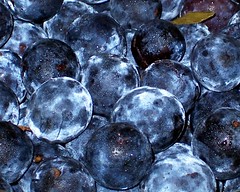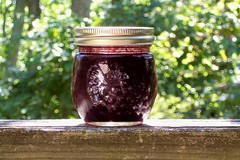Firstly, they are beautiful.

Secondly, they are not something you find often. They are small and sour and clingstone, so they aren't the sort of thing that Safeway is going to carry. Only one of the farmers at the market even has them.
They are also a legitimately ancient fruit. The name 'damson' is dwindled down from 'Damascenum', reflecting where they were probably first grown. Apparently damson pits have been found in archaeological digs of Roman camps across England, though I can't find a specific archaeological report to give you. I can point you to Linda Farrar's squib 'Luxury and design in Roman gardens' (British Archaeology 41 (February 1999); scroll down) which attests that the Romans introduced damsons into Britain. They've been part of English country life ever since -- Mrs Beeton has an astonishing number of recipes for them. They were introduced to America by English colonists, but fell out of favour as ever bigger and sweeter fruits were preferred. The trees are extremely hardy and will hang on in places where other plums fail, however, so in spite of commercial disinterest damsons are still around.
Oh, here's another link for you: Morphological and genetic studies of waterlogged Prunus species from the Roman vicus Tasgetium (Eschenz, Switzerland) (Journal of Archaeological Science Volume 32, Issue 10, October 2005, Pages 1471-1480). Sloe, damson, and European plum, all at one Roman site in Switzerland. This article also has some really interesting-looking bibliography.
My initial plan was to make a sort of sweet pickle with my haul, but the plums were ripe verging on overripe and I think pickles are almost always best made with slightly underripe fruit. Ripe fruit tends to collapse into jam. So jam it was.
The way I made damson jam produces a soft, tart jam. If you like your jam sweeter and firmer, you will need to add more sugar, cook it longer, or add additional pectin in some way.
For 2 1/2 pounds of damsons, I used about 1 1/4 pounds of sugar. I put the sugar in the bottom of my use-it-for-everything Le Creuset cocotte with 2 tablespoons cider vinegar, and set it over low heat, stirring occasionally, until the sugar has melted. It is OK to let the sugar carmelise a bit, but watch it like a hawk so it doesn't burn.
Instead of the cider vinegar you could use lemon juice. If you do that, you could also put the lemon pips into a cheesecloth bag and add them in with the plums to help gel your jam.
While the sugar is melting, wipe the plums with a soft cloth -- if, like me, you have 10,000 linen tea towels, one of those will be fine -- and prick each one a few times with a fork. When the syrup is ready, add the damsons, stir a few times to coat them, then cover and let simmer for 15 minutes or until the skins burst.
At this point I broke out my trusty food mill, put in the coarsest sieve, and ladled the plums into it a few at a time. The mill breaks up any that haven gone completely to mush yet, sends the juice and pulp back into the pot, and allows me to pick out the skins and pits with a minimum of bother. If you do not have a food mill (why not?) you can do the same thing with a small steel colander and a wooden spoon, though the bother will be increased.
Once the skins and pits are separated, taste the jam, add more sugar if you want, and consider adding spices. I used maybe half a teaspoon of ground cloves and 2 teaspoons of cinnamon, but adjust to your own taste. Stir it up well and leave it to simmer, uncovered, until it has thickened. If you are unsure of how thick is thick, or want to be certain it's really going to gel, I'd suggest using a candy thermometer and boiling the jam until it reaches 225 F. If you're going the candy thermometer route, try to boil it up fast, otherwise it will either reduce too much or lose its lovely colour, or both, before it hits temperature.
The jam is a lovely colour, a most astonishing shade of red, like garnets or pomegranates:

Now it is time to put it into jars. This is something I learned to do at my mother's knee, so it is no big thing. If you are not an experienced canner, please check out one of the many books or websites on the subject. The company behind the famous Ball jars has some useful guides, or you could check out Putting Food By if you want a truly comprehensive education.
My 2 1/2 pounds of damsons made about 4 pints of jam:

That's about 4 pints of invincible summer.

That looks delicious. I had some damson jam at a friend's house, and had been wondering about it. some fruit is so incredibly delicious when you cook it with a little sugar -- my favorite is Montmorency cherries.
ReplyDeleteMontmorency cherries are wonderful too. I think there's something about sour fruits in general which is just more satisfying than the cloyingly sweet kind.
ReplyDelete